Weightlifting Mesocycles Part 4: Competition Phase for Weightlifters
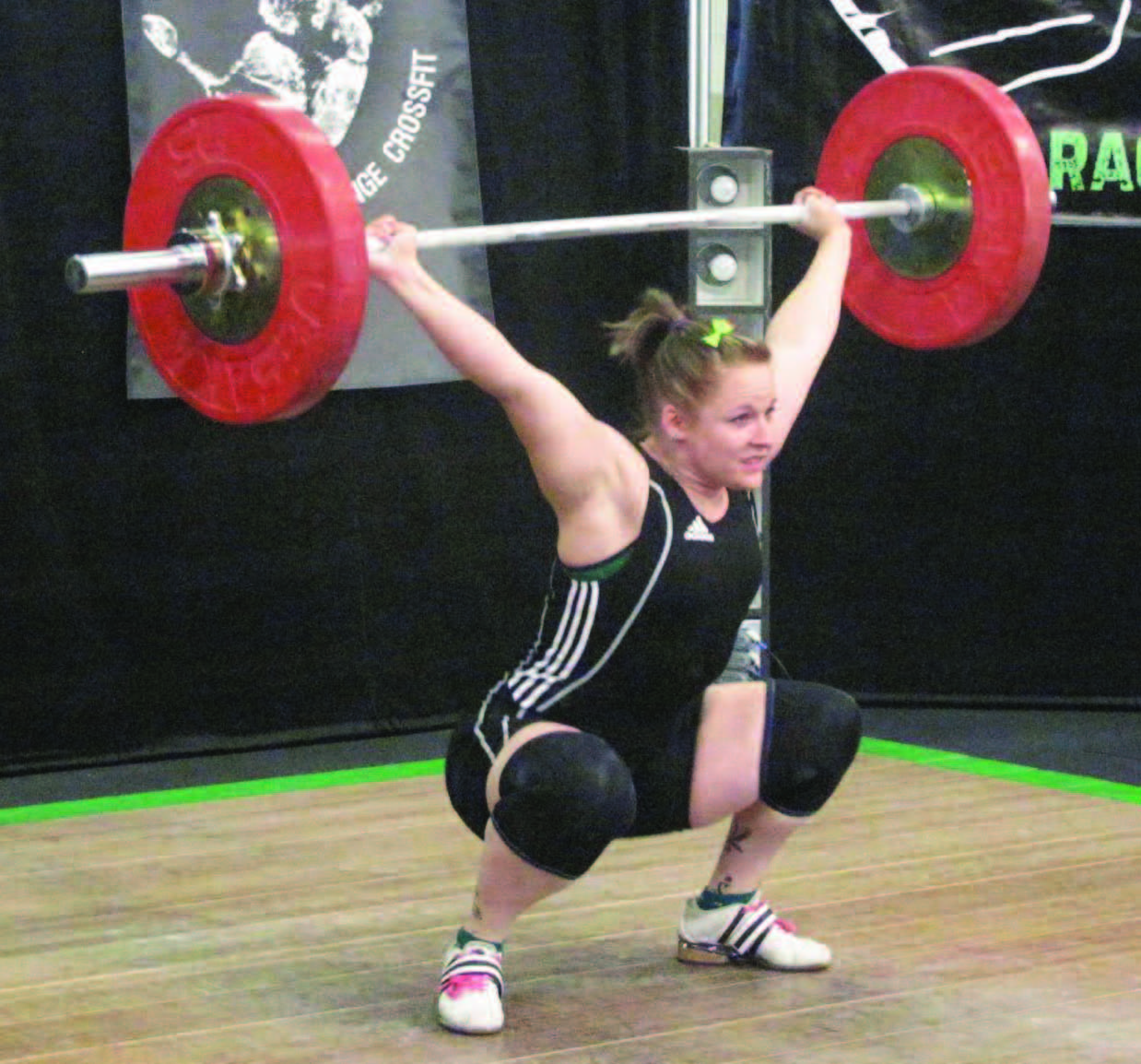
Last month’s topic, the value of power, is followed with this month’s pinnacle topic of the competition phase. The three previous mesocycles will all lead up to this final phase. Previous articles have focused on the importance of each phase and why. Whether, as a coach, one observes technical, strength, power, work capacity or psychological flaws in their lifters, this final phase will make apparent any shortcomings of the previous three phases. With athletes of this caliber, beginning athletes in years one through three, coaches can expect to see great improvements. If athletes are not making progress, coaches must reevaluate their program.
Whether the coach is a USA Weightlifting Level I or a Senior International coach, at this level, the focus of the program should be to have fun and keep beginning athletes coming back to the gym to train. The pedigree of the coach is irrelevant. What is relevant is how the coach works with the athletes. If coaches take the time to work closely with their athletes and show general interest, athletes will make progress. Higher level coaches may get their athletes to higher levels quicker than lower level coaches but again, the main focus is to increase the amount of weightlifters in this sport and to grow local weightlifting clubs. Producing champions is a by-product of its surroundings. A comprehensive training regime set in a positive training environment will spawn improvement, confidence and positive attitudes in all facets of life for lifters which, in turn, will produce success for the coach.
This mesocycle will primarily focus on the classical movements, the snatch and clean & jerk, and therefore, will have the highest average intensities compared to the previous mesocycles. Assistance exercises will be limited to technique work, pulling, squatting and overhead work. This article will focus on how Front Range Weightlifting Club transitions its athletes from the three previous phases of GPP, general strength and power to the competition phase.
The Basic Structure
As with the preceding mesocycles, the competition phase will last four weeks. However, instead of the third week being a recovery week after two hard weeks, in this phase, the four weeks will have continually decreasing volume concluding with the taper/competition week. All of the hard work has been done and now the athlete will focus on the consistency of high intensity classical movements. Days one and three will have higher intensity snatch and clean & jerk, pulls and squats while day two will focus on partial technical movements focusing on individual shortcomings. As average intensity continues to increase, volume continues to decrease. All work capacity exercises will cease and basic cardiovascular conditioning will rely on previous work. However, athletes will continue with a general warm-up, specific dynamic warm-up and limited explosive plyometrics and core.
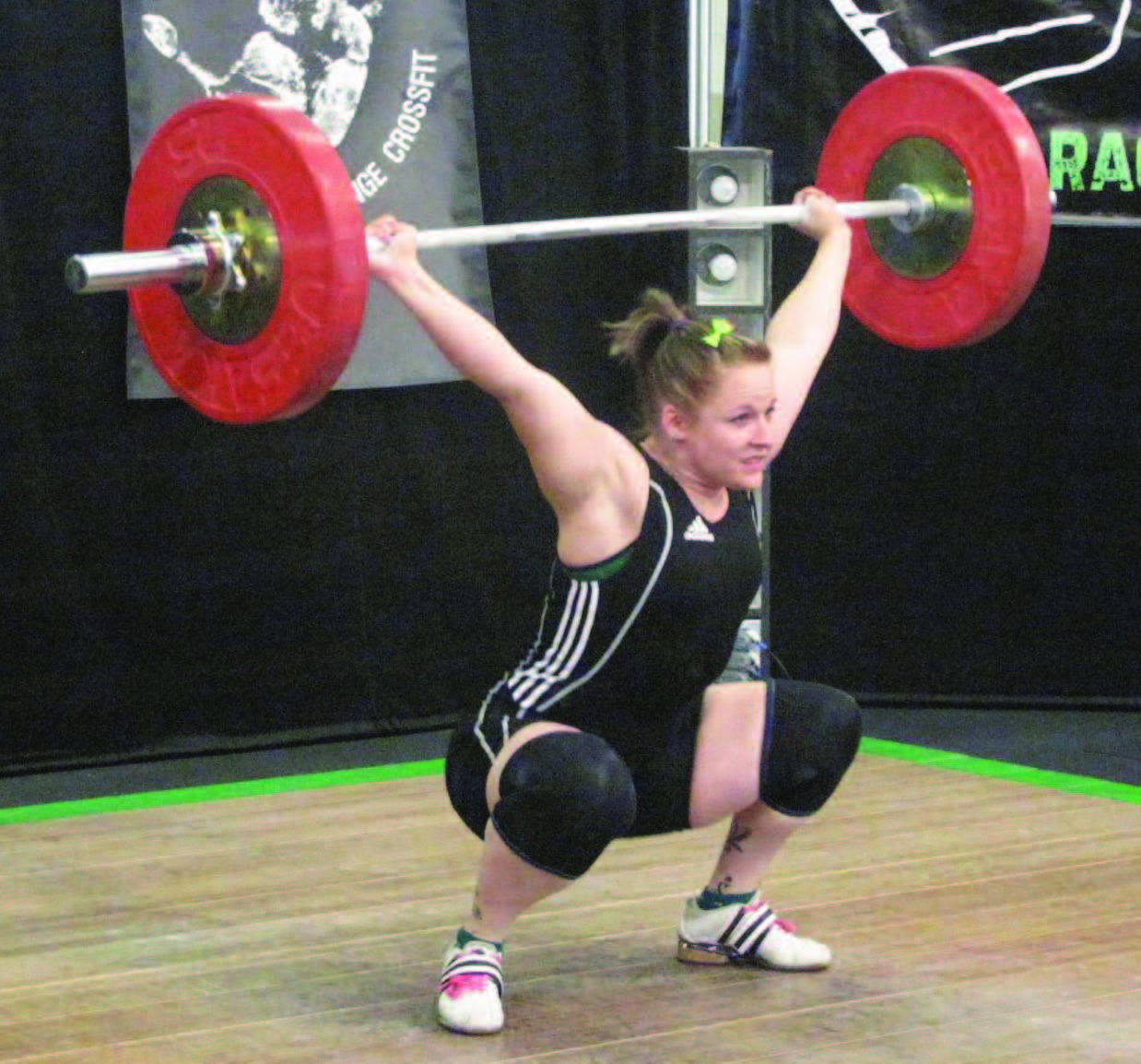
Warming up
The psychological preparation of training begins much sooner in the competition phase than any other phase. Athletes, even beginners, start to mentally prepare for the workout hours before they walk in the gym. However, psychological aptitude cannot prepare for physical deficiencies. Therefore, a low level general warm-up like dynamic stretching, light rowing, bodyweight exercises or easy medicine ball throws are still implemented. This not only prepares the body but gives the mind the chance to rid anxiety. Sets, reps and exercises should be limited to specific weightlifting movements designed to heighten the neurological system. For example, three to four dynamic exercises limited to five to eight repetitions for one set should be sufficient. Plyometrics are limited to no more than ten dynamic reps. Additional time can be spent on bar work centering on full range of motion movements through partial and full competition lifts. The entire warm-up including the plyos should take less than ten minutes with given rest periods.
Volume & Intensity
The competition phase can be fickle for the athlete and coach alike. Athletes may have gotten the appropriate rest and nutrition with optimal mental preparation, only to have a poor training day. Conversely, athletes may have been so busy throughout the day absolutely no time was spent preparing for the workout and find themselves with a slew of personal records at day’s end. Either situation may leave the athlete and coach wondering how the weightlifting gods work! Coaches soon realize, sometimes much sooner than the athlete, whether good or bad, not to put too much emphasis on one training day. If the athletes look good, push them. If they look average, pull in the reigns. Either way, it is up to the coach to get the most out of their athletes, whichever day it is.
In the competition phase, contrary to the other three phases, each week will have less volume and a corresponding increase in intensity. Volume will still be non-linear, varying between approximately 185 repetitions in week thirteen to 50 repetitions during the tapering of week sixteen. It would not be unusual to have an average intensity at 90% or above during the competition phase. However, with the volume decreasing by as much as 50% compared to the power phase, recovery should be adequate, especially for this age group.
In the snatch and clean & jerk, reps will be limited to singles and doubles. Squatting, pulling and overhead exercises will be limited between one and three reps. Individual technical exercises will be restricted to doubles and triples working between 70-85%.
Exercise Selection
Reiterating the goals of this mesocycle, emphasis on the classical lifts should be the main priority while maintaining leg and overhead strength with additional emphasis on technique if necessary. The following microcycle is week fifteen from the Front Range Weightlifting Club program:
Day 1:
General warm-up: Row 500 meters
Specific warm-up: Barbell circuit performed with empty bar with minimal or no rest
• 5 Muscle snatches below knee
• 5 Squat to press
• 5 Front squats
• 5 Overhead squats
Plyometric: Box jumps: 2x5
Weightlifting workout:
1. Snatch with 90 seconds rest: 3x2, 4x1
2. C&J with 2 minutes rest: 3x2+2, 4x1+1
3. Snatch pulls: 4x3
4. Front squats: 1x3, 2x2, 2x1
5. Core:
Back extension 2x8
Total reps: 54
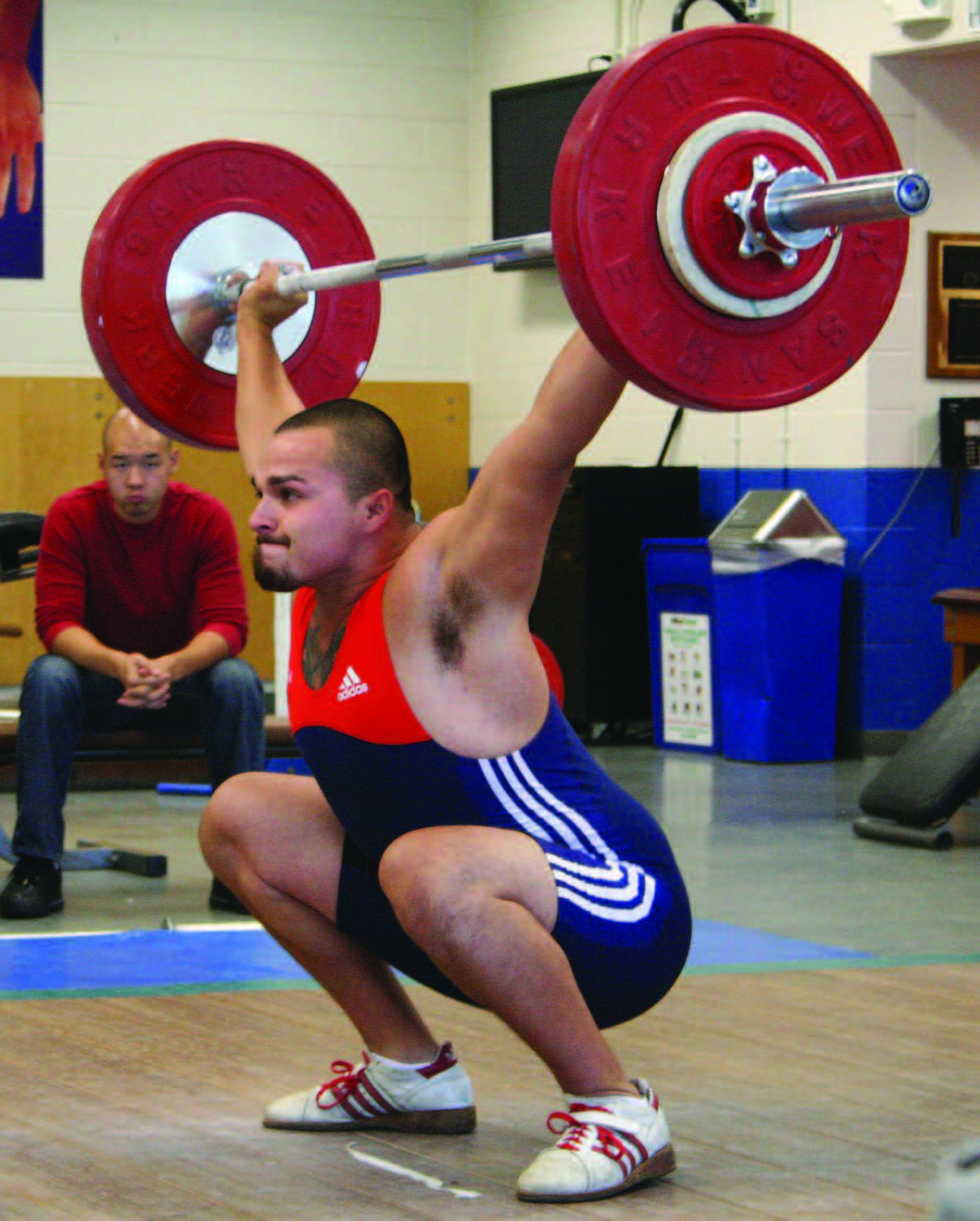
An easy row followed by an empty barbell circuit, performed once or twice and explosive box jumps should be an adequate warm-up. Coaches should give the athletes approximate numbers to hit for the snatch and clean & jerk exercises. The lifts should be performed as if preparing for a competition. Time limits can be given to mimic a competition. Pulls should be at 100% while front squats can be pushed, and if lifter wants to go for a personal record, it should be encouraged. Unloaded back extensions can be used as core.
Day 2:
General warm-up: Light rope skipping or double unders for two minutes
Specific warm-up: Barbell circuit performed with empty bar with minimal or no rest
• 5 Muscle snatches below knee
• 5 Squat to press
• 5 Front squats
• 5 Overhead squats
Plyometric: Hurdle jump + box jump: 3x3
Weightlifting workout:
1. Overhead squats: 4x3
2. Snatch: 5x2
3. C&J: 5x2+2
4. Push press: 4x3
5. Core:
• Weighted abs: 2x10
Total reps: 54
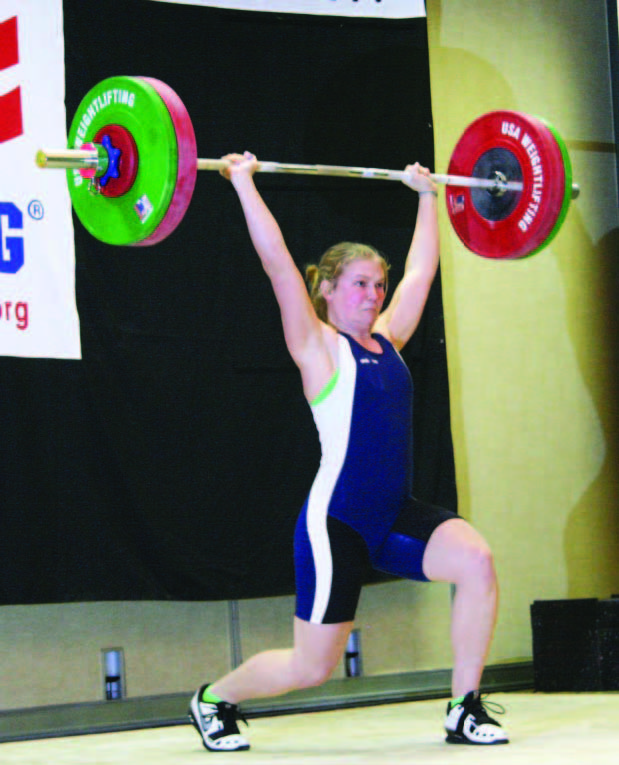
Day 2 is more like an active recovery day. Although the snatch and clean & jerk are in the workout, average intensity for both movements should be around 75-80%. After some easy rope skipping and the barbell circuit from day 1, some explosive plyos can be done. The hurdle jump is the reactive plyo, which is immediately followed by the explosive box jump. This is a good exercise to get the neuromuscular system going. Overhead squats are a good warm-up exercise. Lifters don’t have to go very heavy; this is mainly to loosen up the shoulders and hips. In the snatch and clean & jerk movements, ensure the lifters are focusing on technique and not going heavier than about 85%. Some lifters are still not used to doing the classical snatch and clean & jerk three days per week, so this is a good introduction. For athletes who want or need to go heavier in the push press, the sets and reps can be manipulated for their individual needs.
Day 3:
General warm-up: Bodyweight circuit
Specific warm-up: Barbell circuit performed with empty bar with minimal or no rest
• 5 Muscle snatches below knee
• 5 Squat to press
• 5 Front squats
• 5 Overhead squats
Plyometric: Depth jump + box jump: 3x3
Weightlifting workout:
1. Snatch with 90 seconds rest: 3x2, 4x1
2. C&J with 2 minutes rest: 2x2+2, 4x1+1
3. Clean pulls: 4x3
4. Squats: 1x3, 2x2, 2x1
5. Core:
• Russian twist: 2x12 each side
Total reps: 47
Total weekly volume: 155 reps
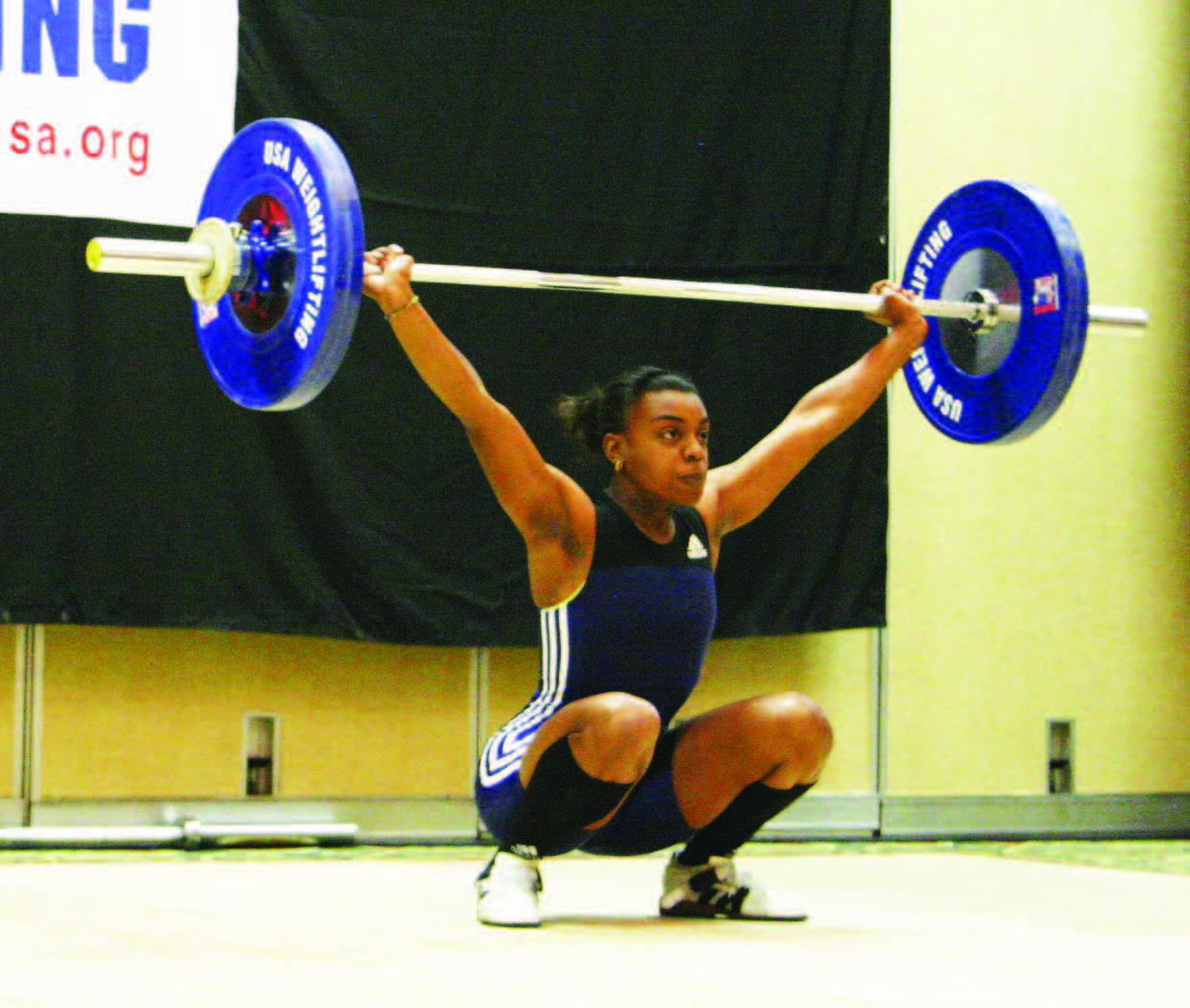
The warm-up for day 3 can be a bodyweight circuit. Four to five exercises of 8-10 reps of squats, push-ups, lunges, dips and the like can be done. This will be followed by the empty barbell circuit and then some dynamic plyos.
The day 3 workout will be very similar to day 1. The coach and lifter alike should have some numbers in mind. Sometimes the coach’s goals may be a little more realistic than the lifter’s goals. As before, if the lifter looks good, let them go heavy and if they do not look good, hold them back and try to make as much as possible with minimal misses. Opening attempts are always a good goal to have since in a competition these are the most important attempts. After opening attempts are made, take it lift by lift.
Following the lifts, the lifters can then try to make a personal record in squats. Since this is the last heavy day before the competition, now would be a good time to attempt one. Squat personal records are always a good indicator of strength since the classical movements correlate so highly with squats. Typically, if the squat increases, so do the lifts.
It is important for coaches to remember during the competition phase to try to get the most out of their athletes without them suffering an injury. Because the competition phase is four weeks long, athletes will have more than several occasions to try to get personal records. Some training sessions will be good and others will not. If the athletes are not feeling it on a day they are supposed to go heavy, it is better to err on the conservative side rather than risk an injury or to psychologically defeat the lifter. If lifters have a positive mental attitude and are healthy going into a competition, chances are they will have a good experience.
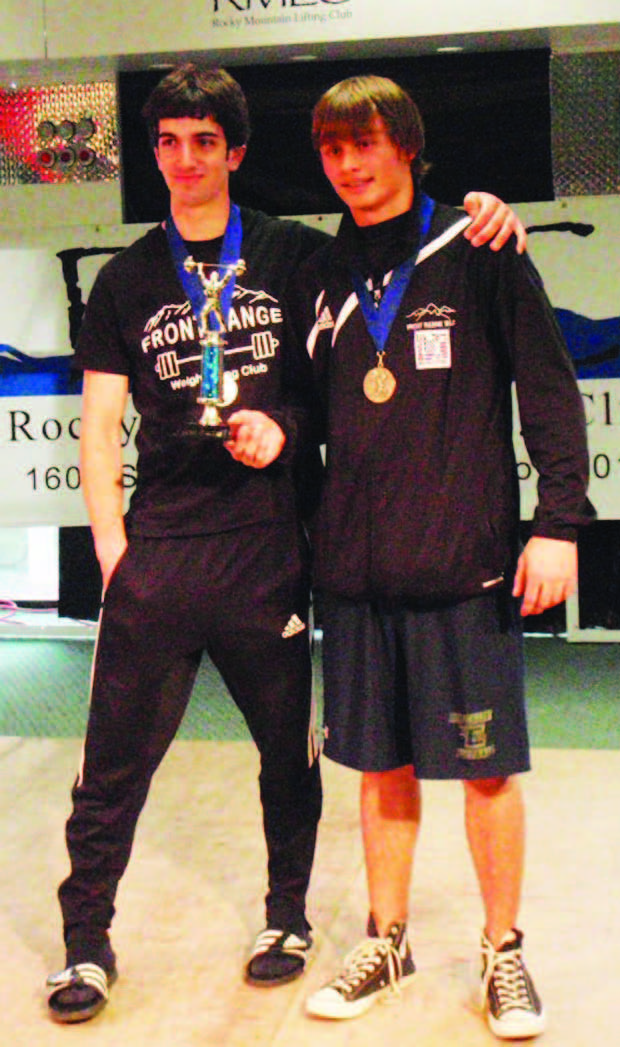
In Conclusion
A successful competition is the apex of training. It breeds confidence for the lifter, coach and the weightlifting club as well. However, to attain success at a competition, the GPP, strength and power phases must be successful as well. A comprehensive sixteen week program in a positive environment will certainly bring success.
The last four articles show how the Front Range Weightlifting Club prepares its beginner athletes for competitions. It is a stepping stone designed to build a foundation to prepare our lifters for higher level training and competitions. The program can be used as a guideline and not a panacea. Each coach at a weightlifting club has the best knowledge about his particular lifters and situation. Coaches may find aspects of our program useful and others not so much. However, most will agree, having a plan that works for their respective situation is better than no plan at all.
Feel free to send questions or replies to me at garagetraining@gmail.com or redrockscrossfit@gmail.com.
Whether the coach is a USA Weightlifting Level I or a Senior International coach, at this level, the focus of the program should be to have fun and keep beginning athletes coming back to the gym to train. The pedigree of the coach is irrelevant. What is relevant is how the coach works with the athletes. If coaches take the time to work closely with their athletes and show general interest, athletes will make progress. Higher level coaches may get their athletes to higher levels quicker than lower level coaches but again, the main focus is to increase the amount of weightlifters in this sport and to grow local weightlifting clubs. Producing champions is a by-product of its surroundings. A comprehensive training regime set in a positive training environment will spawn improvement, confidence and positive attitudes in all facets of life for lifters which, in turn, will produce success for the coach.
This mesocycle will primarily focus on the classical movements, the snatch and clean & jerk, and therefore, will have the highest average intensities compared to the previous mesocycles. Assistance exercises will be limited to technique work, pulling, squatting and overhead work. This article will focus on how Front Range Weightlifting Club transitions its athletes from the three previous phases of GPP, general strength and power to the competition phase.
The Basic Structure
As with the preceding mesocycles, the competition phase will last four weeks. However, instead of the third week being a recovery week after two hard weeks, in this phase, the four weeks will have continually decreasing volume concluding with the taper/competition week. All of the hard work has been done and now the athlete will focus on the consistency of high intensity classical movements. Days one and three will have higher intensity snatch and clean & jerk, pulls and squats while day two will focus on partial technical movements focusing on individual shortcomings. As average intensity continues to increase, volume continues to decrease. All work capacity exercises will cease and basic cardiovascular conditioning will rely on previous work. However, athletes will continue with a general warm-up, specific dynamic warm-up and limited explosive plyometrics and core.

Warming up
The psychological preparation of training begins much sooner in the competition phase than any other phase. Athletes, even beginners, start to mentally prepare for the workout hours before they walk in the gym. However, psychological aptitude cannot prepare for physical deficiencies. Therefore, a low level general warm-up like dynamic stretching, light rowing, bodyweight exercises or easy medicine ball throws are still implemented. This not only prepares the body but gives the mind the chance to rid anxiety. Sets, reps and exercises should be limited to specific weightlifting movements designed to heighten the neurological system. For example, three to four dynamic exercises limited to five to eight repetitions for one set should be sufficient. Plyometrics are limited to no more than ten dynamic reps. Additional time can be spent on bar work centering on full range of motion movements through partial and full competition lifts. The entire warm-up including the plyos should take less than ten minutes with given rest periods.
Volume & Intensity
The competition phase can be fickle for the athlete and coach alike. Athletes may have gotten the appropriate rest and nutrition with optimal mental preparation, only to have a poor training day. Conversely, athletes may have been so busy throughout the day absolutely no time was spent preparing for the workout and find themselves with a slew of personal records at day’s end. Either situation may leave the athlete and coach wondering how the weightlifting gods work! Coaches soon realize, sometimes much sooner than the athlete, whether good or bad, not to put too much emphasis on one training day. If the athletes look good, push them. If they look average, pull in the reigns. Either way, it is up to the coach to get the most out of their athletes, whichever day it is.
In the competition phase, contrary to the other three phases, each week will have less volume and a corresponding increase in intensity. Volume will still be non-linear, varying between approximately 185 repetitions in week thirteen to 50 repetitions during the tapering of week sixteen. It would not be unusual to have an average intensity at 90% or above during the competition phase. However, with the volume decreasing by as much as 50% compared to the power phase, recovery should be adequate, especially for this age group.
In the snatch and clean & jerk, reps will be limited to singles and doubles. Squatting, pulling and overhead exercises will be limited between one and three reps. Individual technical exercises will be restricted to doubles and triples working between 70-85%.
Exercise Selection
Reiterating the goals of this mesocycle, emphasis on the classical lifts should be the main priority while maintaining leg and overhead strength with additional emphasis on technique if necessary. The following microcycle is week fifteen from the Front Range Weightlifting Club program:
Day 1:
General warm-up: Row 500 meters
Specific warm-up: Barbell circuit performed with empty bar with minimal or no rest
• 5 Muscle snatches below knee
• 5 Squat to press
• 5 Front squats
• 5 Overhead squats
Plyometric: Box jumps: 2x5
Weightlifting workout:
1. Snatch with 90 seconds rest: 3x2, 4x1
2. C&J with 2 minutes rest: 3x2+2, 4x1+1
3. Snatch pulls: 4x3
4. Front squats: 1x3, 2x2, 2x1
5. Core:
Back extension 2x8
Total reps: 54

An easy row followed by an empty barbell circuit, performed once or twice and explosive box jumps should be an adequate warm-up. Coaches should give the athletes approximate numbers to hit for the snatch and clean & jerk exercises. The lifts should be performed as if preparing for a competition. Time limits can be given to mimic a competition. Pulls should be at 100% while front squats can be pushed, and if lifter wants to go for a personal record, it should be encouraged. Unloaded back extensions can be used as core.
Day 2:
General warm-up: Light rope skipping or double unders for two minutes
Specific warm-up: Barbell circuit performed with empty bar with minimal or no rest
• 5 Muscle snatches below knee
• 5 Squat to press
• 5 Front squats
• 5 Overhead squats
Plyometric: Hurdle jump + box jump: 3x3
Weightlifting workout:
1. Overhead squats: 4x3
2. Snatch: 5x2
3. C&J: 5x2+2
4. Push press: 4x3
5. Core:
• Weighted abs: 2x10
Total reps: 54

Day 2 is more like an active recovery day. Although the snatch and clean & jerk are in the workout, average intensity for both movements should be around 75-80%. After some easy rope skipping and the barbell circuit from day 1, some explosive plyos can be done. The hurdle jump is the reactive plyo, which is immediately followed by the explosive box jump. This is a good exercise to get the neuromuscular system going. Overhead squats are a good warm-up exercise. Lifters don’t have to go very heavy; this is mainly to loosen up the shoulders and hips. In the snatch and clean & jerk movements, ensure the lifters are focusing on technique and not going heavier than about 85%. Some lifters are still not used to doing the classical snatch and clean & jerk three days per week, so this is a good introduction. For athletes who want or need to go heavier in the push press, the sets and reps can be manipulated for their individual needs.
Day 3:
General warm-up: Bodyweight circuit
Specific warm-up: Barbell circuit performed with empty bar with minimal or no rest
• 5 Muscle snatches below knee
• 5 Squat to press
• 5 Front squats
• 5 Overhead squats
Plyometric: Depth jump + box jump: 3x3
Weightlifting workout:
1. Snatch with 90 seconds rest: 3x2, 4x1
2. C&J with 2 minutes rest: 2x2+2, 4x1+1
3. Clean pulls: 4x3
4. Squats: 1x3, 2x2, 2x1
5. Core:
• Russian twist: 2x12 each side
Total reps: 47
Total weekly volume: 155 reps

The warm-up for day 3 can be a bodyweight circuit. Four to five exercises of 8-10 reps of squats, push-ups, lunges, dips and the like can be done. This will be followed by the empty barbell circuit and then some dynamic plyos.
The day 3 workout will be very similar to day 1. The coach and lifter alike should have some numbers in mind. Sometimes the coach’s goals may be a little more realistic than the lifter’s goals. As before, if the lifter looks good, let them go heavy and if they do not look good, hold them back and try to make as much as possible with minimal misses. Opening attempts are always a good goal to have since in a competition these are the most important attempts. After opening attempts are made, take it lift by lift.
Following the lifts, the lifters can then try to make a personal record in squats. Since this is the last heavy day before the competition, now would be a good time to attempt one. Squat personal records are always a good indicator of strength since the classical movements correlate so highly with squats. Typically, if the squat increases, so do the lifts.
It is important for coaches to remember during the competition phase to try to get the most out of their athletes without them suffering an injury. Because the competition phase is four weeks long, athletes will have more than several occasions to try to get personal records. Some training sessions will be good and others will not. If the athletes are not feeling it on a day they are supposed to go heavy, it is better to err on the conservative side rather than risk an injury or to psychologically defeat the lifter. If lifters have a positive mental attitude and are healthy going into a competition, chances are they will have a good experience.

In Conclusion
A successful competition is the apex of training. It breeds confidence for the lifter, coach and the weightlifting club as well. However, to attain success at a competition, the GPP, strength and power phases must be successful as well. A comprehensive sixteen week program in a positive environment will certainly bring success.
The last four articles show how the Front Range Weightlifting Club prepares its beginner athletes for competitions. It is a stepping stone designed to build a foundation to prepare our lifters for higher level training and competitions. The program can be used as a guideline and not a panacea. Each coach at a weightlifting club has the best knowledge about his particular lifters and situation. Coaches may find aspects of our program useful and others not so much. However, most will agree, having a plan that works for their respective situation is better than no plan at all.
Feel free to send questions or replies to me at garagetraining@gmail.com or redrockscrossfit@gmail.com.
| Paul Fleschler is the owner of Front Range Sports Performance & Fitness and RedRocks CrossFit in Colorado Springs. He earned a masters degree in Motor Control and Learning from Indiana University, is a Certified Strength & Conditioning Specialist and USA Weightlifting Senior International Coach where he has represented the United States at several international weightlifting competitions as Head and Assistant Coach. As an athlete, Paul’s greatest honor was representing the United States at the 1992 Barcelona Olympics. Paul is the former Men’s National Coach and former Men’s and Women’s Resident Coach at the Olympic Training Center in Colorado Springs. He also served in a supportive role for USA Weightlifting at the 2004 and 2008 Olympic Games. Paul assisted with 20 varsity sports at Indiana University, and served as the Head Strength Coordinator for Indiana University Basketball. |
Search Articles
Article Categories
Sort by Author
Sort by Issue & Date
Article Categories
Sort by Author
Sort by Issue & Date

